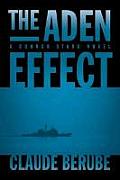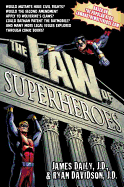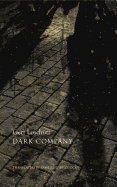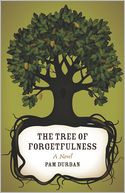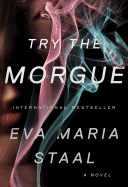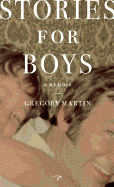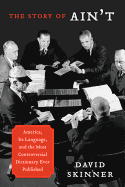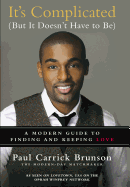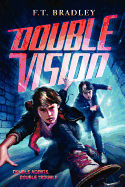It all started with a book cover. In the latest University of Washington Press catalogue, one cover caught my eye: vibrant orange, the word "pumpkin" in white. I instantly visualized bright bookstore displays with the book as centerpiece. But it's more than a pretty cover--Pumpkin: The Curious History of an American Icon by Cindy Ott is a fascinating look at how a simple squash became mythic. We drive to the country to harvest a vegetable (really a fruit) that we don't eat, but could; instead, we buy canned pumpkin for our pie fillings. We carve pumpkins into elaborate shapes.
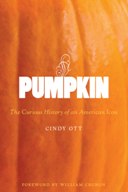 As William Cronon says in the introduction, our world is filled with things we take for granted: "Only when we ask how they came to be... do we recognize how strange and wondrous they truly are." That's what Ott does with Pumpkin. When and why did we relegate the pumpkin to a twice-a-year appearance? Before the late 19th century, pumpkin appeared in beer more often than dessert, although with Lincoln's 1863 proclamation of Thanksgiving as a national holiday, the pie die was cast. In contrast to the humble, nurturing, quintessentially American pie is the jack-o'-lantern: the "wild and mischievous" master of ceremonies for pranks and trick-or-treating. But Ott doesn't just discuss dessert and Halloween; farming practices, our ideas about nature and the purity of rural life, the creation of a pumpkin that does not reproduce but is easy to paint, the infusion of pumpkin patches with moral values--all contribute to a captivating book about an iconic American symbol.
As William Cronon says in the introduction, our world is filled with things we take for granted: "Only when we ask how they came to be... do we recognize how strange and wondrous they truly are." That's what Ott does with Pumpkin. When and why did we relegate the pumpkin to a twice-a-year appearance? Before the late 19th century, pumpkin appeared in beer more often than dessert, although with Lincoln's 1863 proclamation of Thanksgiving as a national holiday, the pie die was cast. In contrast to the humble, nurturing, quintessentially American pie is the jack-o'-lantern: the "wild and mischievous" master of ceremonies for pranks and trick-or-treating. But Ott doesn't just discuss dessert and Halloween; farming practices, our ideas about nature and the purity of rural life, the creation of a pumpkin that does not reproduce but is easy to paint, the infusion of pumpkin patches with moral values--all contribute to a captivating book about an iconic American symbol.
But back to the painted pumpkin idea. I got this site from Robert Gray, one of our writers: Carving Hacks. When I wondered, Where are the pumpkin Daleks?, he sent this. Get out the knives! --Marilyn Dahl, book review editor, Shelf Awareness
Dark Company: A Novel in Ten Rainy Nights
by Gert Loschutz, transl. by Samuel P Willcocks
Ten very wet stories of floods and rainstorms make up Gert Loschutz's Dark Company, a set of surreal wanderings through the drenched streets of a nameless German town, as well as through the labyrinths of memory. Narrator Thomas is a 35-year-old skipper who lost his barge to a wrecker's yard and has since worked as an agent for several transportation companies and as the captain of a ship. His tales of adventure have the authenticity of Joseph Conrad, but with a modern unreliability and faltering over details more like Kafka. The fragments of plot, blurred by the passage of time, are rife with missing chunks of information and confused identities, with people who look like friends and lovers from his past but may not be, or who mistake Thomas for someone else.
For Loschutz, atmosphere is all. His tales are full of indirection and suggested connections; meaningful looks are exchanged, mysterious notes change hands. In "It's Not Friday Yet," Thomas may have witnessed a murder, and provides readers with clues that hover on the edge of a conclusion we can't quite see.
Loschutz's stories-within-stories are workingman's tales zigzagging from Berlin to Manhattan, from Vienna to Poland. His heroes are truckers and porters, bargemen and naval cadets, on boats and trains and cross-country trucks, making their way through the fog and the rain, encountering little horrors along the way. --Nick DiMartino, Nick's Picks, University Book Store, Seattle
Discover: A rainstorm unleashes 10 tales of floods and barges and mistaken identities, as Loschutz spins classic German weird fiction with a contemporary blue-collar twist.
The Tree of Forgetfulness
by Pam Durban
Feel-good civil rights-era fiction like The Help tends toward obvious heroes and villains; everyone wants to feel the resolution of being on the right side of history. But in Pam Durban's chilling and nuanced The Tree of Forgetfulness, no blinding light brings the hateful to account, leaving the poison of violence to foul the water for generations. Durban's precise, beautifully evocative prose builds to a brief but breathtaking meditation on the true legacy of racial violence.
Durban bases her novel on a real-life triple lynching in 1920s South Carolina, when three members of an African-American family, accused of murdering a white deputy, were pulled from jail by a mob and savagely killed. She recalls the events of the case through a cast of indelible characters that includes a local businessman whose culpability is hard to pin down, the black woman who keeps his house--and, begrudgingly, his secrets--and a world-weary reporter from the North whose contemptuous poking of the locals is akin to stirring up a nest of bees.
In an easier story, the reporter would uncover the truth, debts would be paid and wrongs, if not righted, would be at least acknowledged. But The Tree of Forgetfulness illuminates a murkier, and more authentic-feeling, truth. Late in the story, when an aging white matron comes to her black housekeeper's funeral wrongly assuming the affection she felt for her employee was returned, the piercing internal dialogues of Durban's characters hauntingly illustrate the undying mistrust that grew out of the bloody Southern soil. --Cherie Ann Parker, freelance journalist and book critic
Discover: A spare, beautiful and bracing story based on a 1926 lynching in South Carolina.
Stonemouth
by Iain Banks
Scotsman Iain Banks published his first novel, The Wasp Factory, in 1984. It received much critical attention, good and bad. His portrait of Frank, a teenage serial killer of members of his own family, was famously described by the Irish Times as a work of "unparalleled depravity." Banks has gone on to a prolific career writing fiction as Iain Banks and writing science fiction as Iain M. Banks.
Stonemouth opens with narrator Stu Gilmour, the "exile," standing in the rain on a bridge on Stoun Firth, Scotland, that's famous for suicides. It leads into the town he left five years ago, for what he terms "my sins." He reflects on his class's first suicide, Callum, who jumped from this bridge (or did he?). Stu reflects as well on "clarity"--that "would have been good." But clarity about what?
We follow Stu over the course of a long weekend. Old Murston, of a local crime family, has died and Stu is there, uninvited, for the funeral. He reacquaints himself with old friends and with his old love, Ellie Murston, who still lives in the small town, and reflects over and over on his youthful past. It's been five years, and nothing seems to have changed, except Stu. Another death occurs later, a result of what is and isn't right in Stonemouth and in Scotland, and what never may be right. Banks has fashioned a dark, deep and subtle study of a young man trying to come to grips with himself. --Tom Lavoie, former publisher
Discover: A poignant tale about a young Scotsman who returns home to attend a funeral, confront his past and seek some kind of clarity in his uncertain life.
Mystery & Thriller
The Aden Effect
by Claude Berube
In The Aden Effect, Claude Berube's debut novel, pirates, drug dealers, corrupt politicians and inept military leaders all contribute to a complex plot packed with political conspiracy, military intrigue and international conflict.
When the U.S. ambassador to Yemen, C.J. Sumner, fails in her attempts to build relationships with Yemeni leaders, she uses her influence to recall ex-navy officer Connor Stark to active military duty--assigned to her embassy, where she hopes his connections will help her break down the walls of silence before Washington pulls her out of her position.
Meanwhile, U.S. diplomatic security agent Damien Golzari arrives in Yemen, following a lead in the death of a State Department official's college-aged son. When Golzari and Stark cross paths, Sumner has to convince the two headstrong men they are on the same side and need to work together.
Berube's protagonists are an unlikely match; the straightlaced, impeccably dressed Golzari exudes as much arrogance as the non-traditional, informal Stark. Yet readers will find it difficult to dislike either man. Their foes are easier to dislike, but Berube is equally respectful with them. Smart, determined and realistic, they make the novel's action chillingly believable.
Fans of political thrillers, international espionage or military crime should not let this gem fly under the radar. --Jen Forbus of Jen's Book Thoughts
Discover: A debut political thriller pitting selfish ambition against the greater good. Which is the more powerful force?
Try the Morgue
by Eva Maria Staal
The pseudonymous Eva Maria Staal's first novel, Try the Morgue, deftly marries an edgy thriller to a sensitive literary story. It's narrated by Maria, a woman caught between her desire for a stable family and the emotional rush she gets from lucrative, illegal gun deals. Maria goes to work for Jimmy Liu, who teaches her all about clandestine weapon shipments, backroom brokering, bickering among dealers and slipping across borders under fake papers. Jimmy's personal attention attracts her as much a rich deal does. "He sees things in me that I don't see," she explains, "that no one sees."
Maria's narrative moves fluidly between her past and her present. Today she is moving to a suburb of Amsterdam with her architect husband, Martin, and their daughter, Nella. Her domestic life is one of playdates and conversations over coffee with Nella's schoolmate's mother. Yesterday, though, she was dealing carbines and Chinese-made Stingers--"not exactly something to be handing out in Karachi," she admits. "But it's a living."
When Jimmy disappears in a deal gone wrong and, after she's tried all the hospitals, the local police tell her to "try the morgue," Maria is haunted by the words of his sword-making grandfather: "Swords don't take sides." Staal doesn't take sides either, but instead lets Maria tell her own story, where the sides she must choose between are not political, but personal... and that choice is the most difficult. --Bruce Jacobs, founding partner, Watermark Books & Cafe, Wichita, Kan.
Discover: Staal, a former arms dealer, fictionalizes the dilemma of a young woman caught between the thrill of international gunrunning and the security of family and home.
The Art Forger
by B.A. Shapiro
In The Art Forger, B.A. Shapiro's sixth and best suspense thriller yet, Claire Roth, an accomplished painter in her own right, uses her skills to paint forgeries for Repro.com. The company sells her art work to clients who know the paintings are fake--for a "reasonable" price customers can enjoy the experience of having great masterpieces adorning their walls. Claire is especially good faking paintings by Edgar Degas. She hates to do it, but she's very good at it and the money allows her to pay her bills, just barely.
But first some history, true and false. In March 1990, two men stole 13 works of art from the Isabella Stewart Gardner Museum in Boston. The catch included such priceless masterpieces as Rembrandt's Storm on the Sea of Galilee and Vermeer's The Concert. Today, the value of the paintings would be over $500 million. For two decades, the FBI has investigated the robbery, following leads from all over the world. The museum still asks anyone who has any information about the theft to contact the FBI. A $5-million reward awaits. All true.
However, there was one "stolen" painting that never existed--Degas's After the Bath. It's a painting whose existence was created by Shapiro in order to provide a masterpiece around which her story is carefully built. And not just one story, but three. Shapiro artfully weaves three separate tales to tell the story of the art forger. The first is about Claire and her reproduction job and her desire to make it as a painter. The second is a flashback story from three years ago, about Claire and her lover, Isaac Cullion, whom Claire met when he was a teacher and she his student. Finally, there is the story told through letters written by Isabella Stewart Gardner, one of the greatest female art patrons, to her (fictional) niece Amelia in the 1880s-90s, when Gardner was in Paris looking for artworks to acquire and for artists--including Degas--to meet and befriend (true).
And so, when Aiden Markel, a gallery owner who knows Claire and Isaac, comes to her apartment with a financially rewarding proposal to paint a copy of the stolen Degas's After the Bath, a favorite of hers, she's both repulsed and intrigued. It would be challenging, and the money would be welcome. Markel also offers Claire his gallery for her own show, her first ever, a great opportunity to display her ongoing series of window paintings. She finally agrees, as long as the painting will never be public and will remain only in the hands of the mysterious wealthy collector who thinks he will have the stolen original. One day, in a big crate, the masterpiece to be copied is delivered--she stares at it "as if my eyes are tethered to the canvas." Markel has promised her the original will be surreptitiously returned to the Gardner once her copy is completed.
Claire begins her forgery. Shapiro does an excellent job of giving us fascinating information and details about the art of painting and how a good forgery is actually made: "I've ground the underpaint--flake white, raw umber, and turpentine mixed with a touch of sienna to warm it up--to my exacting and secret recipe. A red sable brush, ridiculously expensive, but the only kind of soft brush Degas ever used, stands at the ready. I immerse the brush in the small bowl of underpaint, close my eyes, and visualize the final painting.... I begin. Underpainting is fast and straightforward. The perfect first step for a long project."
As she paints, her thoughts turn to the origins of Bath. She knows the painting well, having stood before its genius at the museum many times. But something seems wrong. Could this be a forgery? Could the original have been a fake? If so, where is the real Bath? She sets out to learn more about Gardner's relationship with Degas and arranges to meet Sandra Stoneham; her grandmother, Amelia, was Gardner's niece.
All the threads now start to intertwine as Shapiro deftly takes on the role of magician, dazzling us with ingenious slights of hand and a narrative juggling act. Watching her bring all the pieces together makes for an exciting and very pleasurable read. If you love art, a mystery, and a tale of unrequited love, this tale is for you. --Tom Lavoie
View the book trailer for The Art Forger here.
Biography & Memoir
Stories for Boys: A Memoir
by Gregory Martin
Stories for Boys opens as Gregory Martin learns that his father has attempted suicide. The reasons for overdosing come as shocks: he was abused as a child by his own father, and throughout his marriage of nearly four decades, he has resorted to anonymous sexual encounters with more than 1,000 men. Martin, the father of two young boys himself, is filled with anger and feels betrayed.
Martin's mother--who brings her husband home from the hospital and immediately tells him to move out--is a university administrator, and her husband has followed wherever her career led, making a hodgepodge employment record for himself as a P.E. teacher, a traveling salesman, a real estate agent, a kitchen designer, a speech pathologist. Except for living a sexual lie, he was the perfect husband and father.
Martin's provocative account of the shattering and healing of his family takes the unusual angle of admitting his often judgmental, uncompassionate responses to his father's confession. His determination to come to grips with his own intolerance and sense of betrayal is the heart of Stories for Boys; watching him find new ways to love the father he never completely knew becomes emotionally exhilarating.
His memoir becomes profoundly touching as he takes himself to task, and over it all presides the spirit of his guiding light and inspiration, Walt Whitman, able to become sympathetic with any passing stranger, open to all, forgiving to all. --Nick DiMartino, Nick's Picks, University Book Store, Seattle
Discover: Martin's touching memoir chronicles his shock and gradual acceptance of his father's revelation of a childhood of abuse and secretly being gay.
Closer to the Ground
by Dylan Tomine, illus. by Nikki McClure
Dylan Tomine--a fly-fishing ambassador for the outdoors company Patagonia--used to pursue steelhead year-round from Argentina to Southeast Alaska, but after watching wild steelhead decline and becoming a father, he returned home to the Pacific Northwest to be a blueberry farmer. Closer to the Ground is a narrative journey that follows his family through four seasons of intentionally noticing their natural environment and getting in touch with the day-to-day rhythms of tide, weather and the seasons. Tomine emphasizes that they aren't completely off the grid; they don't live in a yurt and they aren't strangers to the mall, but they do attempt to keep in touch with their surroundings: "I can only hope that somehow, though participating in the natural world, our need to protect it becomes more urgent."
Tomine weaves his memoir with lyrical passages, family dialogues and accounts of gathering shellfish and chanterelles--as well as delicious descriptions of cooking them--in an engaging, slightly self-deprecating tone. Particularly poignant is his description of a snowy egret that he sees when returning home from a fishing trip. It reminds him of his grandfather, "a forager of spring fiddleheads and forest mushrooms, a poet who wrote a single, perfect haiku for every day he was held in the [Japanese] relocation camps." Alongside these beautiful passages are Tomine's frustrations of fishing expeditions hindered by squalls and his constant worry about chopping enough firewood to last through the winter. Closer to the Ground inspires readers to examine their own daily lives and rediscover their surroundings. --Kristin McConnell, publishing assistant, Shelf Awareness
Discover: A deeply personal account of one family learning to connect with nature through foraging, cooking and eating.
History
The Story of Ain't: America, Its Language, and the Most Controversial Dictionary Ever Published
by David Skinner
There was a time when a dictionary represented "a symbol of genteel aspirations," David Skinner writes: "a password for culture, a ticket to knowledge, a compendium of all that was known and worth knowing." When Noah Webster set about creating the first comprehensive dictionary of the American language in the 1820s, it helped define the national identity. Some 140 years later, the editors of Webster's Third decided to focus on how the language was used and spoken, not on how some thought it should be used and spoken. The ensuing battle for language supremacy is the subject of Skinner's delightful new book on lexicography, The Story of Ain't.
Webster's Third was a snapshot of American English, epitomized by the inclusion and acceptance of one word that was seized on and vilified by language purists: "ain't." While Webster's Second was embraced wholeheartedly by scholars and critics as the "supreme authority" of the English language after its publication in 1934, the Third was scorned for accepting common English, including slang and colloquialisms. Philip Gove's dictionary was contrarian to accepted scholarly traditions, a linguistic trailblazer that sought to modernize American English. (One of its most outspoken critics, longtime Columbia scholar Jacques Barzun, denounced such linguistic innovation as the enemy of civilization.) Skinner leaves no doubt as to the importance of Webster's Third as the game-changer in dictionary standards and the impetus for an American cultural metamorphosis. --Nancy Powell, freelance writer
Discover: The word that set off class warfare and changed the way Americans viewed their spoken language.
Current Events & Issues
The Law of Superheroes
by James Daily and Ryan Davidson
It takes a certain kind of geekery to enjoy a deep conversation about comic books, and another kind to enjoy a conversation about the niceties of legal doctrine. When these forces combine, the result is bound to be a superpowered geekery of epically entertaining proportions--which is precisely what James Daily and Ryan Davidson's The Law of Superheroes delivers.
The Law of Superheroes, based on Daily and Davidson's blog Law and the Multiverse, explores the law as it might be applied in comic books: Can Batman patent the Batmobile? When Superman nabs the bad guys, is he obligated to read them their Miranda rights? Does the Second Amendment protect weaponized superpowers, like Cyclops's laser vision or Wolverine's claws? And just how many laws has Tony Stark (with or without his Iron Man armor) violated in his career, anyway? (Answer: a lot.)
Law can be the driest of subjects, and comic book debates can bore the non-initiated to tears. In The Law of Superheroes, however, Daily and Davidson manage to make both subjects accessible even to readers with no background or interest in either. The Law of Superheroes provides both a clear introduction to most primary areas of U.S. law and to the major characters, themes and events of many popular comic book universes. A must-read for a dose of good geeky fun. --Dani Alexis Ryskamp, blogger at The Book Cricket
Discover: A fun and well-researched introduction to legal concepts through case studies of superheroes and their super-exploits.
Psychology & Self-Help
It's Complicated (But It Doesn't Have to Be)
by Paul Carrick Brunson
It's hard to imagine anyone has anything new to add to the subject of finding and keeping love, but Paul Carrick Brunson, a former investment banker now known as a matchmaker and Dr. Drew Pinsky's go-to relationship expert, believes new rules are needed for the age of Google and online dating. As the average age for marriage continues to rise due to career options and expanding mobility, "it's time the book of love got an upgrade," Brunson proposes--hence, It's Complicated (But It Doesn't Have to Be).
Brunson admits there will always be enduring common-sense guidelines regarding relationships, and explores those universal rules while providing "homework" in the form of questions to determine whether someone is truly ready for marriage. He also explains how to distinguish relationship non-starters from preferences, while avoiding "type hype" (do you really need the person you believe you want?) and identifying truly compatible personality types. His concrete advice regarding appearance, body language and landing dates leads to a game plan for finding, recognizing and keeping love--as well as spotting when (and how) to move on.
Brunson's rules, intended to help the lonely find healthy, sustainable relationships, are appropriate for every age, gender and sexual orientation. Although many of the suggestions are neither groundbreaking nor surprising, the section on setting up and maintaining a healthy online identity and presence will be helpful to anyone, even those who have successfully found love.--Kristen Galles, blogger at Book Club Classics
Discover: Dr. Drew's relationship expert provides a fresh, modern approach to the timeless search for love.
Children's & Young Adult
Crewel
by Gennifer Albin
What would it be like to be born with a talent that could help shape the world, and with it, the power to give life or take it? That is Adelice Lewys's predicament in Gennifer Albin's gripping debut novel, the first in a planned trilogy, about growing up and taking responsibility for the gift she is given.
The people of Arras revere the Spinsters, the skilled weavers who create and maintain their world. At 16, Adelice goes to be tested, and reveals herself to be one of the most talented weavers the Guild of Twelve has ever seen. When Cormac Patton, the Coventry Ambassador for the Guild of Twelve, and his team come to collect Adelice, her family attempts to flee. But Adelice is captured, her father killed, and the fates of her mother and sister are unknown. The author asks probing questions about whether Adelice's rare talent is a blessing or a curse. Each thread represents a life, and it gets Adelice thinking about whether a ripped thread can be saved. It's a moment that resonates with poignancy later in the novel, when Loricel, the most powerful Spinster in Arras, asks Adelice to remove a thread of an older woman. Only Loricel understands the burden that her gift places upon Adelice.
In this first installment, Adelice must decide whether to assume this god-like responsibility, or find a way to escape. Readers will be eager to return to the coming episodes to see how her choice affects the world around her. --Jennifer M. Brown, children's editor, Shelf Awareness
Discover: Sixteen-year-old Adelice, a weaver with an unparalleled talent to shape her world, is forced to make impossible choices.
Double Vision
by F.T. Bradley
Alex Rider fans will eagerly gobble up this adventure featuring an ordinary boy attempting to save the world with zero skills.
Twelve-year-old Lincoln Baker is a troublemaker expelled after his latest prank imposes legal consequences on his school and family. These are problems that the top-secret special ops team, Pandora, can make disappear--if Linc can successfully impersonate their top junior agent, Benjamin Green, who's gone missing. The mission: travel to Paris to rescue Jacques Mégére, who's been taken captive by a criminal organization for hiding an evil Mona Lisa that can create mass hypnosis. Linc may be a dead ringer for Benjamin Green, but he doesn't have a black belt in karate and can't run five miles at Olympic speed. His cover is blown quickly--by both tech-genius Henry (who also appears to be Benjamin Green's biggest fan) and Jacques's feisty daughter, Françoise. Run-ins and switch-ups with the real Benjamin Green keep readers turning the pages, while the codes and ciphers keep them guessing.
F.T. Bradley's hero is driven by great intentions, remains hilariously mischievous and discovers a great deal about himself during this exciting undercover mission. The ending hints at more adventures to come. This debut novel will be welcomed by devotees of Eoin Colfer's Artemis Fowl series and M.E. Castle's Popular Clone. --Adam Silvera, reviewer and former bookseller
Discover: An ordinary boy impersonates an extraordinary junior agent--but the only thing they have in common is their appearance.


